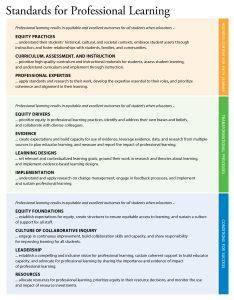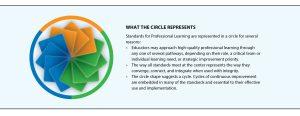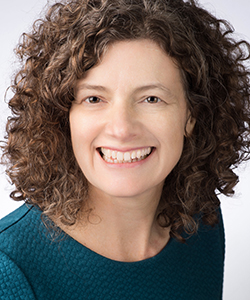FOCUS
New look, new standards
By Tracy Crow
Categories: Fundamentals, Implementation, Leadership, Learning communities, Learning designs, Standards for Professional LearningJune 2022
Leaders in North River School District (a fictional district) were disappointed. For two years, they had known their middle grades students were struggling in reading and language arts. They had instituted a range of efforts to improve instruction, such as longer reading blocks and one-on-one tutoring. But when they looked at end-of-year student achievement results and educator survey data, they recognized that their recent efforts had not been effective. Student achievement had remained flat or, in some cases, fallen. Even more troubling, the declines were steepest for students from marginalized communities.
The leaders had a difficult conversation about which efforts to abandon, which to continue, and which new paths to pursue to ensure all students would excel in reading and language arts. The directors of curriculum and professional learning presented research showing the impact of investing in high-quality curriculum and instructional materials. The group agreed that they needed to overhaul their curriculum.
But the superintendent pointed out that a new curriculum would have little impact if teachers and other staff did not have a deep understanding of its content and practices. To vigorous head nods from the professional learning and curriculum directors, she explained that the district would need to prioritize professional learning linked to the new curriculum.
With many decisions and plans to be made, the professional learning director recommended that the leadership team look to Standards for Professional Learning to formulate a strategy that would ensure high-quality, research-based professional learning.
Learning Forward’s Standards for Professional Learning define and describe professional learning that leads to improved educator practices, leadership, and student outcomes. Standards draw on the latest evidence and research about what works in professional learning to help educators implement every phase of the professional learning process. They help stakeholders design, lead, facilitate, support, and evaluate professional learning to advance school and system priorities so that all students learn at high levels.
Wherever they are used, Standards for Professional Learning establish common language, definitions, and expectations for professional learning. They set a high bar for the learning that educators experience, just as student content standards do. While student standards outline what students should know and be able to do, Standards for Professional Learning describe at a high level what educators learn, the processes for educator learning, and the conditions in schools, systems, and other organizations that support powerful learning.
“Standards for Professional Learning set a high bar for the learning that educators experience, just as student content standards do.” Share on XDriving progress for the future
In April 2022, Learning Forward released the revised edition of standards. It builds on the knowledge and expertise created through the three earlier iterations (for more on the history of standards read this article). The new edition builds on the solid foundation of the past to drive progress for the future.
The latest iteration of Standards for Professional Learning includes 11 standards. Underscoring the need for a systemic approach across levels, Standards for Professional Learning work within a framework of three categories: Rigorous Content for Each Learner, Transformational Processes, and Conditions for Success. The three categories echo earlier versions of Standards for Professional Learning that organized standards by context, process, and content.
This article describes each of the three framework categories and illustrates how they can look in practice, drawing on the fictional example of North River School District.
Rigorous content for each learner
Standards within the Rigorous Content for Each Learner frame describe the essential content of adult learning that leads to improved student outcomes. That content will vary depending on the learner and their roles, experiences, and career pathways.
While many of the skills and competencies described in these three standards may seem to apply most directly to teachers, every educator has a responsibility to identify and prioritize their highest learning needs related to each of these standards. For example, while a teacher’s connection to the Curriculum, Assessment, and Instruction standard is obvious given their daily responsibilities, principals also study the curriculum carefully to support its use, evaluate teachers’ implementation, and, in some cases, lead professional learning.
The three standards in this category are Equity Practices; Curriculum, Assessment, and Instruction; and Professional Expertise (see the full list of standards and statements here). These standards refer to both student and educator learners — while the content for educator learning is what the standards detail, the tight link between educator and student learning is always a high priority.
In our North River School District example, the Rigorous Content for Each Learner standards informed the design of curriculum-based professional learning. A cadre of professional learning leaders, including district and school leaders as well as coach supervisors and the directors of professional learning and curriculum, recognized that the new English language arts curriculum would itself serve as a key text in teachers’ professional learning. They had been intentional in selecting a highly rated curriculum in which the materials included embedded support for teachers.
Based on their study of the standards in the Rigorous Content for Each Learner frame, they designed additional strategies for supporting teachers on the new curriculum. They turned to the teacher leaders in each middle school and offered them support in helping grade-level teams identify critical concepts from the student standards and how the curriculum addressed them.
The teacher teams examined student data to understand which concepts students were struggling with, indicating a learning need for educators, and paid particular attention to how student outcomes varied along a range of demographic characteristics including race, gender, and ability. With this information in hand, teachers, teacher leaders, and the professional learning cadre had a clear vision for the content for professional learning for the coming months.
Transformational processes
Standards within the Transformational Processes frame describe process elements of professional learning, explaining how educators learn in ways that sustain significant changes in their knowledge, skills, practices, and mindsets. The four standards in this category are Equity Drivers, Evidence, Learning Designs, and Implementation. They address how to plan inclusive professional learning that recognizes learners’ identities and beliefs, plan and evaluate learning using multiple types of data, align learning designs with evidence about what works and with learner goals and priorities, and sustain learning over time.
Those responsible for day-to-day professional learning operations and processes will likely engage most deeply with these specific standards, whether they are instructional coaches honing their skills to offer feedback to peers and learning teams or directors of professional learning creating embedded, ongoing learning for a specific initiative or curriculum. But educators at all levels need to understand high-quality professional learning processes, whether to recognize the importance, for example, of investing their time and energy as an individual learner with a coach, to support colleagues in exploring unconscious bias so they can collaborate fully with diverse colleagues, or as a system leader to understand that change takes time as well as long-term investment and support.
In North River, system- and school-level leaders reflected on all the knowledge they had gathered so far and discussed how to ensure that the professional learning structures they had established followed best practices for adult learning. They looked to the standards in the Transformational Processes frame to ensure they put the key pieces in place.
First, they examined their existing processes. The district had previously contracted with a vendor to support curriculum implementation during the summer, but a survey of teachers indicated that while they found the workshops engaging, they hadn’t actually used any of what they learned. Recognizing the need for a more sustained and job-embedded approach, as outlined in the standards, they decided to integrate professional learning into educators’ workdays. They made a plan to leverage the instructional coaches that supported each school, sustain learning implementation throughout the school year, and support coaches and teacher leaders in using relevant learning designs in this work.
With the effective implementation of new curriculum and instructional resources as their strategic priority, professional learning leaders recognized that teachers would benefit from using the materials just as students would use them, so they helped coaches learn how to incorporate activities and lessons from the curriculum as part of their work with teachers. They also discussed the importance of creating learning that would include every educator’s voice and recognize each educator’s identity and assets, given the diverse makeup of the workforce in the system.
Conditions for success
Standards within the Conditions for Success frame describe aspects of the professional learning context, structures, and cultures that undergird high-quality professional learning. The standards that address conditions are Equity Foundations, Culture of Collaborative Inquiry, Leadership, and Resources. Within these standards live the actions that establish guiding visions for professional learning tied to excellent and equitable outcomes for students, as well as the importance of educators learning in collaboration and having the knowledge and skills to do so effectively. Conditions standards address the importance of leadership across all levels of schools and systems and the intentional use and allocation of resources.
Standards in this category apply most directly to system and school leaders with positional authority and responsibility to create visions and systems for professional learning and establish cultures across teams, schools, or the district, not to mention those with power to determine resource use. Yet educators at every level are responsible for the effective use of learning time, for example, when it is allocated for team learning, or for exercising leadership in their contexts when they demonstrate the impact of their learning or speak up for what they need. Every educator has the responsibility to engage as an active and skilled collaborator and recognize the direct links between their learning and that of their colleagues and students.
In our North River School District example, Conditions for Success helped create a culture and climate in which high-quality professional learning could thrive.
The team-based cycles of continuous improvement at North River did not happen in a vacuum. They were supported and motivated by leaders’ deep dive into the Conditions for Success frame of the standards. Through that process, the professional learning cadre articulated and cultivated a culture of shared, high expectations for each learner, both educators and students. They also engaged all educators in discussion about their commitment to establishing professional learning as a lever to address inequities in students’ and educators’ access and opportunity for powerful learning.
North River’s system and school leaders also recognized that high-quality, curriculum-based professional learning relies on creating connections among colleagues and departments, including the department of curriculum and instruction and the department of teaching and learning. They realized that close collaboration among those departments would result in alignment and common priorities for resource allocation. The common vision to connect educator learning with the drive for rigorous and equitable student outcomes was essential to forward progress.
With a plan to continue cultivating these conditions for success while deepening implementation of the processes and content, the district’s leaders felt well-positioned to make positive changes in teaching and learning.
Where does a professional learning system start?
To create high-quality professional learning that results in improved educator practices and improved student results, educators apply all standards in concert. In contrast, when educators focus on one or several standards to the exclusion of others, they will be less likely to achieve the ambitious results they seek.
At the same time, educators don’t learn about or use all the standards at once. They need to have an entry point to begin developing a full understanding. “Which standard should we start with?” is a common question for educators new to standards. It’s a tough question to answer because the only true response is, “It depends.”
To decide where to begin, educators could identify a known area of high need. For example, if educators know that the problem they need to address through professional learning is ensuring that students of color experience rigorous teaching and learning, they might look at the Equity Practices standard and learn that the content of educator learning can emphasize how to take a wide range of student assets and aspects of identity into account.
Or perhaps educators know they have time set aside for collaborative learning but that they aren’t using team time effectively, so they decide to study the Culture of Collaborative Inquiry standard. If they know their district or school is lacking an intentional systemwide context for professional learning, they might start with the Conditions for Success frame.
Educators might also enter standards through an area of strength or to continue an ongoing initiative. For example, educators engaged in learning cycles may wish to strengthen how they’re using data and evidence to inform planning and thus explore the actions associated with the Evidence standard.
A school leader may recognize that the professional learning associated with implementing a new language arts curriculum has helped teachers make significant strides in using high-quality materials and wish to take that learning up a notch in the coming year, so they study the Curriculum, Assessment, and Instruction standard and the Learning Designs standard, as did the educators in the North River system depicted throughout this article.
Whichever standard an educator or team of educators begins with, they will then connect to other standards to best achieve the results they seek. For example, if looking in depth at a standard in the Rigorous Content for Each Learner frame, such as Professional Expertise, is the starting point, a good next step would be considering how to design learning around that content.
This would take educators into both the Conditions for Success and Transformational Processes frames, which would spur educators to think about questions such as “How will that learning be designed?” and “How will the learning fit into a larger system for supporting other educators over time?” Step by step, this is how a high-quality system for professional learning is built.
Connecting the dots to lead to impact
After their first year of professional learning focused on curriculum implementation, the professional learning cadre at North River School District reflected on their progress. They noted several successes and identified a handful of lessons grounded in ongoing use of Standards for Professional Learning to inform future planning
First, as they looked at preliminary evidence from middle grades classrooms, they recognized that most classrooms advanced on most of the concepts identified as focus areas for improvements. However, they didn’t see all classrooms advance and hypothesized that not every teacher had enough support to engage in the collaborative structures that support collective impact.
Next, they shared notes from several focus group conversations that coaches had conducted with teachers. They learned that most teachers had a high level of satisfaction with their learning and reported ongoing implementation of new practices. In one building, however, the teacher responses indicated that their schedules hadn’t given them enough time for practice and reflection. They made a plan to work with the school leader to adjust schedules accordingly.
As they considered these and other lessons, grounding their reflections in the standards, the professional learning cadre determined that most essential for the next year of learning was a more intentional emphasis on the vision for learning and improvements to creating coherence in learning across the district. With this priority and several other specific steps in mind, the cadre knew Standards for Professional Learning would continue to help them shape a high-impact learning system to support every educator and student in their district.
Download pdf here.

Who are Standards for?
Standards for Professional Learning are intended to be used by educators and stakeholders in awide range of positions within and outside of schools and school systems to clarify what constitutes high-quality professional learning.
- For those educators with daily responsibilities to plan and facilitate professional learning, the standards provide guidance for both short- and long-term planning, implementation, and support, as they did for the directors in the vignette in this article. In addition to directors of professional learning and curriculum, the standards are used in this way by instructional coaches, external assistance providers, principals, and others.
- For educators with leadership responsibilities in systems, such as superintendents and chief academic officers, standards offer insights on how to ensure educators experience equitable access to high-quality professional learning year-round through the provision of sufficient resources and the establishment of supporting structures and visions.
- Policymakers use Standards for Professional Learning so that relevant funds are tied to actions that lead to results for adult and student learners.
- Researchers and those in higher education turn to standards to inform their related work, whether to structure research studies, explore particular concepts in depth, or align preservice education to evidence-backed educator learning.
- Leaders in education organizations and associations align their support for educators in a range of school improvement priorities to standards to improve its efficacy and outcomes.
What the circle represents

Designing for impact


Tracy Crow served as chief strategy officer for Learning Forward.
Categories: Fundamentals, Implementation, Leadership, Learning communities, Learning designs, Standards for Professional Learning
Recent Issues
WHERE TECHNOLOGY CAN TAKE US
April 2024
Technology is both a topic and a tool for professional learning. This...
EVALUATING PROFESSIONAL LEARNING
February 2024
How do you know your professional learning is working? This issue digs...
TAKING THE NEXT STEP
December 2023
Professional learning can open up new roles and challenges and help...
REACHING ALL LEARNERS
October 2023
Both special education and general education teachers need support to help...










